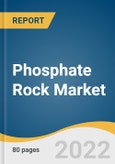The global phosphate rock market size is expected to reach USD 29.73 billion by 2030. It is expected to expand at a CAGR of 3.2% from 2022 to 2030. The increasing demand from the agriculture industry, along with the growing population, is anticipated to fuel the market growth over the forecast period. According to the United Nations, the world population increased by 1.1% from 2017 to 2018 and is projected to reach 9.8 billion in 2050. This is expected to drive the demand for phosphate fertilizers to support the food needs, which, in turn, is expected to propel the utilization of phosphate rock over the coming years. Moreover, growing animal feed production is projected to support the market growth over the coming years.
Phytase is a growing alternative for phosphate feed owing to the high costs of phosphate feeds. It is a vital ingredient in animal feed and affects reproduction, growth, and feed cost. Most of the natural phosphate is unavailable to animals, thus it is important to add inorganic phosphate in diets to compensate for natural phosphate needs. In such cases, phytase is added to improve performance and reduce the cost of animal feed. These benefits of phytase are further expected to affect the market dynamics.
Industrial applications of phosphate rock include cleaners, detergents, incendiary shells, tracer bullets, pyrotechnics, pesticides, metal coatings, toothpaste, cosmetics, pharmaceuticals, anticorrosion agents, matches, and other phosphorus compounds. Demand for synthetic detergents is projected to rise owing to urbanization in emerging economies. Most synthetic detergents contain phosphate as a builder, which improves the phosphate loading rate in water bodies. Thus, the demand from the detergent application segment is projected to benefit the growth of the phosphate rock industry.
The European Union countries are highly dependent on other countries for phosphate rock imports owing to the lack of sufficient phosphate reserves in the region. This leads to high production costs of phosphate fertilizers in the region. The demand for fertilizers is decreasing in Western Europe in contrast to the increasing demand in Eastern Europe. European countries are relying on potassium and nitrogen fertilizers as a result of the high production costs involved with phosphate fertilizers owing to the high phosphate prices.
Phytase is a growing alternative for phosphate feed owing to the high costs of phosphate feeds. It is a vital ingredient in animal feed and affects reproduction, growth, and feed cost. Most of the natural phosphate is unavailable to animals, thus it is important to add inorganic phosphate in diets to compensate for natural phosphate needs. In such cases, phytase is added to improve performance and reduce the cost of animal feed. These benefits of phytase are further expected to affect the market dynamics.
Industrial applications of phosphate rock include cleaners, detergents, incendiary shells, tracer bullets, pyrotechnics, pesticides, metal coatings, toothpaste, cosmetics, pharmaceuticals, anticorrosion agents, matches, and other phosphorus compounds. Demand for synthetic detergents is projected to rise owing to urbanization in emerging economies. Most synthetic detergents contain phosphate as a builder, which improves the phosphate loading rate in water bodies. Thus, the demand from the detergent application segment is projected to benefit the growth of the phosphate rock industry.
The European Union countries are highly dependent on other countries for phosphate rock imports owing to the lack of sufficient phosphate reserves in the region. This leads to high production costs of phosphate fertilizers in the region. The demand for fertilizers is decreasing in Western Europe in contrast to the increasing demand in Eastern Europe. European countries are relying on potassium and nitrogen fertilizers as a result of the high production costs involved with phosphate fertilizers owing to the high phosphate prices.
Phosphate Rock Market Report Highlights
- The fertilizers application segment was the largest segment in 2021 and accounted for a revenue share of over 75.0%. The need to improve crop yield, along with the growing demand for agriculture products such as vegetables and fruits, is projected to remain a key contributing factor for the market growth
- The food and feed additives application segment is anticipated to witness lucrative growth over the forecast period. Phosphate is an important ingredient in animal feed and helps to improve fertility, digestive process, and bone strength in animals
- Asia Pacific was the largest regional market in 2021, in terms of both volume and revenue. The growth of the regional market is attributed to stable agriculture production and demand for food and nutrients for the growing population in countries such as China, India, and ASEAN
- The Middle East and Africa emerged as the second-largest regional market in 2021. The growth of the region is attributed to the availability of phosphorus rock reserves and the production of phosphate fertilizers in the region
Table of Contents
Chapter 1. Methodology and Scope
Chapter 2. Executive Summary
Chapter 3. Phosphate Rock Market Variables, Trends & Scope
Chapter 4. Phosphate Rock Market: Application Outlook Estimates & Forecasts
Chapter 5. Phosphate Rock Market Regional Outlook Estimates & Forecasts
Chapter 6. Competitive Analysis
Chapter 7. Company Profiles
List of Tables
List of Figures
Companies Mentioned
- OCP Group
- The Mosaic Company
- Ma’aden
- PhosAgro
- Guizhou Kailin Holdings (Group) Co., Ltd.
- Yuntianhua Group
- Misr Phosphate
- Hubei Xingfa Chemicals
- Wengfu Group
- Yunnan Phosphate Haikou Co., Ltd. (YPH)
Methodology

LOADING...
Table Information
| Report Attribute | Details |
|---|---|
| No. of Pages | 80 |
| Published | February 2022 |
| Forecast Period | 2022 - 2030 |
| Estimated Market Value ( USD | $ 22.75 Billion |
| Forecasted Market Value ( USD | $ 29.73 Billion |
| Compound Annual Growth Rate | 3.4% |
| Regions Covered | Global |
| No. of Companies Mentioned | 10 |









